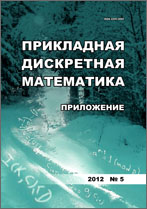|
This article is cited in 1 scientific paper (total in 1 paper)
Mathematical Methods of Cryptography
$\mathsf{XS}$-circuits' properties related to the guaranteed number of activations
D. R. Parfenova, A. O. Bakharevab, A. V. Kutsenkoab, A. R. Belovc, N. D. Atutovaab
a Novosibirsk State University
b Sobolev Institute of Mathematics, Siberian Branch of the Russian Academy of Sciences, Novosibirsk
c P.G. Demidov Yaroslavl State University
Abstract:
The guaranteed number of activations (GNA) is an important characteristic that determines the efficiency of differential cryptanalysis of a given $\mathsf{XS}$-circuit. In the paper, we propose an approach to optimize the known GNA calculation algorithm based on the branch and bound method and the analysis of special matrices that define the $\mathsf{XS}$-circuit. Now, it is possible to compute GNA for more than 30 rounds, which would take significantly longer if the original algorithm were used. The optimized algorithm was used for exhaustive enumeration of low-dimensional $\mathsf{XS}$-schemes. We prove that the canonical forms of the $\mathsf{XS}$-circuit and its dual coincide, which provides a strict connection between the guaranteed number of linear and differential activations. Based on computational experiments, several hypotheses have been proposed. One of the hypotheses is that there are no $\mathsf{XS}$-circuits of dimension greater than two that achieve an optimal GNA in every round.
Keywords:
guaranteed number of activations, $\mathsf{XS}$-circuit, differential cryptanalysis, linear cryptanalysis, branch and bound method.
Citation:
D. R. Parfenov, A. O. Bakharev, A. V. Kutsenko, A. R. Belov, N. D. Atutova, “$\mathsf{XS}$-circuits' properties related to the guaranteed number of activations”, Prikl. Diskr. Mat. Suppl., 2022, no. 15, 62–66
Linking options:
https://www.mathnet.ru/eng/pdma581 https://www.mathnet.ru/eng/pdma/y2022/i15/p62
|

|




 Contact us:
Contact us: Terms of Use
Terms of Use
 Registration to the website
Registration to the website Logotypes
Logotypes








 Citation in format
Citation in format 
